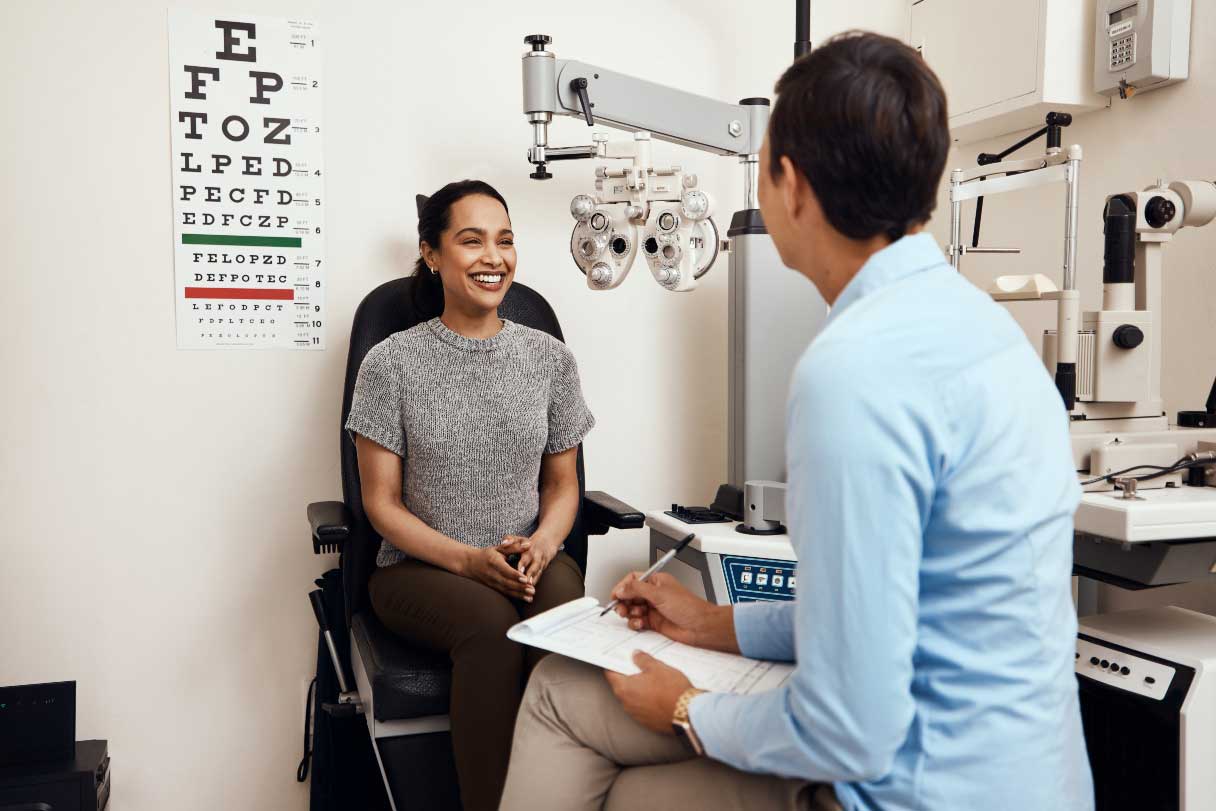Many people will suffer eye injuries at some point in their lives. Whether from an accidental fall, a collision while playing sports or a flying champagne cork, eye injuries can happen anywhere and at any time.
Eye injuries affect about 2.5 million people in the world annually.1 In the U.S. alone, there are about 125,000 serious eye injuries from household products and about 40,000 sports-related eye injuries every year.1 On top of that, about 20,000 eye injuries happen at work each year, ranging from mild eyestrain to blindness.2 But what might seem like a minor eye injury could potentially become serious enough to impact your vision.
Below are 10 of the most common conditions associated with an eye injury or eye trauma. Knowing the most common ones can help you better avoid them.
Read Related Articles
9 Types of Eye Tests That Are Part of a Healthy Eye Exam
Eye Exam Cost and Eye Exam Financing Options
1. Corneal Abrasion
A corneal abrasion occurs when the cornea (the clear area on the front of your eye) gets scratched or poked, often by fingernails, contact lenses or another foreign object. When this happens, your eye might feel painful, watery or be sensitive to light.3
2. Chemical Burns
Chemical burns in your eye are dangerous. In fact, splashed chemicals are one of the top causes of workplace eye injuries.2 They can also happen at home, such as when shampoo or household cleaning products accidentally splash in your eye.4 Some chemicals are more dangerous than others, though all should be taken seriously — oven and drain cleaners, for example, can cause blindness.4
If you splash a chemical in your eye, flush your eye with cool, clean water immediately for at least 15 minutes. Then, get emergency treatment right away if it's a dangerous chemical.4
3. Hyphema
Hyphema refers to bleeding in your eye that pools between the cornea and your iris. Symptoms include pain, blurry vision, blood in your eye or light sensitivity. About 70% of cases happen in children and are often caused by sports injuries, falls, fights or BB guns. Sometimes, eye surgery, diseases or even blood thinners can cause the issue.5
A subconjunctival hemorrhage is another type of eye bleed, but it's a more minor case of a broken blood vessel on your eye's surface. It usually just looks like a small red spot on your eye, and it's less serious than a hyphema.6
That said, if you notice bleeding in your eye, you should see a doctor right away. Don't try to treat it yourself. You'll be given an eye exam and possibly a CT scan.5
4. Orbital Fractures
Orbital fractures typically happen after some kind of object hits your eye. The bones inside your eye socket break, and the muscle that supports your eye might also tear.3
Symptoms can include a black eye, blood in your eye, blurred vision, swelling, numbness or trouble moving your eye.7 See a doctor right away if you suspect this. You'll typically be given a CT scan, X-ray, MRI or ultrasound to identify the bone and soft tissue injuries.3
5. Retinal Detachment
A retinal detachment is a serious injury that can cause you to lose your vision, so you'll need medical attention right away. This injury occurs when your retina (a layer of tissue at the back of your eye) separates from the underlying tissue. Some symptoms can include:8
- Suddenly seeing numerous tiny floaters in your vision
- Seeing flashes of light
- A shadow-like curtain falling over part of your vision
- Losing your peripheral vision
- Blurred vision
Retinal detachment is commonly caused by aging, but it can also be caused by scar tissue on the retina, eye injuries, tumors or certain disorders.8
6. Eye Lacerations
Eye lacerations are cuts or punctures to your eye. If your eye is cut, you should put a protective cover over it right away until you can see a doctor. This covering can be as simple as a paper cup taped around your eye to shield it. Don't rinse your eye, rub it or apply pressure. Avoid medications that can thin your blood, like aspirin.9
7. Foreign Objects in Your Eye
Foreign objects in the eye can range from small particles like dust, dirt or sand to something bigger like metal or glass.9 In fact, flying shards of metal, glass or even wood splinters are among the top causes of workplace eye injuries.2
If something small is in your eye, like sand, your eye might flush it out naturally with blinking and tears. But larger objects could become embedded. Don't rub your eye, but instead, use an eyewash, saline solution or tap water to try to flush your eye out. If this doesn't work or it still seems like something's stuck, seek help at an emergency room.9
8. Photokeratitis
Photokeratitis is the technical term for developing eye injuries from exposure to ultraviolet (UV) radiation. This can be from the sun or a man-made source like a UV tanning bed. The damage can happen not just from direct sun rays but even from sun rays bouncing off the sand, ice, snow or water. Staring at the sun during a solar eclipse can cause the quickest, most long-lasting damage.10
Symptoms include light sensitivity, tearing or feeling like something is in your eyes.4 Other symptoms can include swelling, eye pain, headaches, seeing halos in your vision or vision loss in more severe cases.10 Long-term exposure can put you at greater chance of developing cataracts or macular degeneration.4
If you notice these symptoms, visit an eye doctor. With milder cases, symptoms will often go away on their own. In the meantime, you may need artificial tears, cold compresses and pain relievers.10
Wearing sunglasses or snow goggles that block 99% to 100% of the sun's radiation can help prevent this damage.4 For a solar eclipse, though, you'll need special eclipse glasses that block more light.
9. Blunt Force Trauma
Blunt force trauma (or a blow to the eye) can have many causes, including a fall or a sports injury. You may end up with a black eye from bruising or swelling.3
If you're hit in the eye, gently put a cold compress over your eye first to help reduce swelling or pain, but don't apply any pressure. Seek medical care if bruising, pain or vision changes occur. As with any type of eye injury, resist the urge to rub your eye.9
10. Eyelid Lacerations
Eyelid scratches and injuries are often caused by falling, getting punched in the face, an animal bite, a car crash or a sports injury. Symptoms include redness or swelling around the eyelid, bleeding or fluid discharge, pain, numbness and blurry or distorted vision.11
When to See a Doctor for an Eye Injury
If you have any doubt about an eye injury, it's best to proceed with caution and see a doctor or visit an emergency room.
Some signs to watch out for after an eye injury include:2
- Pain in your eye
- Trouble seeing
- One eye doesn't move as well as the other
- One eye has an unusual pupil size
- Problems focusing or frequent headaches1
- Excessive tears, redness or swelling1
- Spasms in your eye or eyelid1
- Blood in your eye
- A torn or cut eyelid
- Something stuck in the eye that can't be removed
Tips to Help Protect Your Eyes
The good news is that you can reduce your chance of an eye injury by following a few, simple eye protection safety steps:1
- Always wear the appropriate protective eyewear. The right protective gear can prevent about 90% of serious workplace injuries.2
- Remove hazards around the home that may cause falls, and install handrails and lights on stairs.
- If you're using a spray nozzle, turn the nozzle away from your face first.
- Always wash your hands if you use any chemicals, even household cleaners, and read the directions for use carefully.
- Use caution around fireworks or when opening cork bottles or carbonated drinks.
If you or a loved one experience an eye injury, it's important to take it seriously and seek care from a doctor who can provide a diagnosis and treatment if necessary. Many eye doctors list emergency contact information on their website for injuries that occur outside of normal business hours, or you can visit the emergency room at your hospital.
CareCredit Credit Card Financing for Eye Injuries
Whether you're paying for eye surgery or getting an eye exam, the CareCredit credit card can help you pay for care where your insurance leaves off.* Use our Acceptance Locator to find a vision specialist near you that accepts CareCredit. Continue your wellness journey by downloading the CareCredit Mobile App to manage your account, find a provider on the go and easily access the Well U blog for more great articles, podcasts and videos.
In addition to vision care, you can also use your CareCredit credit card for dentistry, cosmetic, pet care, hearing, health systems, dermatology, pharmacy purchases, spa treatments and so much more within the CareCredit network. How will you invest in your health and wellness next?
Author Bio
Stephanie Dwilson specializes in science journalism, breaking news and animal health and is a business owner, non-practicing attorney and writer.








